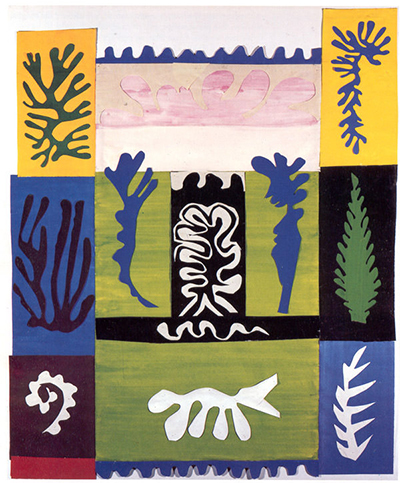Anfitrite dates from 1947 and was one of a number of illustrations completed by Henri Matisse for his Jazz book. There was an exciting blend of cut-outs designs throughout this famous publication.
Within Anfitrite we find several blocks of colour with simple illustrations added over the top. Matisse worked in a particularly abstract manner in his latter years, partly forced by his worsening health. Work in oils would become particularly difficult and so cut-outs and simple illustrations became a more appropriate medium. He loved particular colours, most of which were very bright and could leave behind a powerful impact. In this case he chooses blue and yellow as the main opposition to the standard black and white colours. There is also a smaller use of green and purple just to add a little more interest. Whilst most parts of the scene are flat colours, there is some gradients of tone with the background of the centre which helps to give a feeling of depth to that part.
There is a marine theme to this design, with shapes resembling a few items that you might find floating around at the bottom of the ocean. There is certainly an organic feel to this piece though the two sides are relatively abstract frames. In the middle we see what appears to be a landscape view, with grass leading up to a pink cloud scene. There are further abstract shapes too as Matisse attempts to work in as expressive a manner as possible. Matisse was an incredibly gifted, creative individual who could constantly re-invent himself under whatever challenges he faced. He wanted to continue to produce art for as long as he lived and refused to give up even when certain techniques could not be carried out any more.
Perhaps Matisse's most famous artworks remain the likes of Dance, Snail and Goldfish but in truth he was able to leave behind a huge legacy which offers plenty of variety across the many decades of work. French art owes a debt of gratitude to this man for his ability to impress throughout the 20th century and keep the nation at the forefront of modern art. It received a challenge from the US which started to take over during the rise of the Abstract Expressionists, though France itself has dominated in previous centuries, particularly with the much loved Impressionists who were mainly focused on landscape painting. Today Matisse's work feels just as contemporary and fresh as it ever has done, underlining the groundbreaking nature of it at the time.




